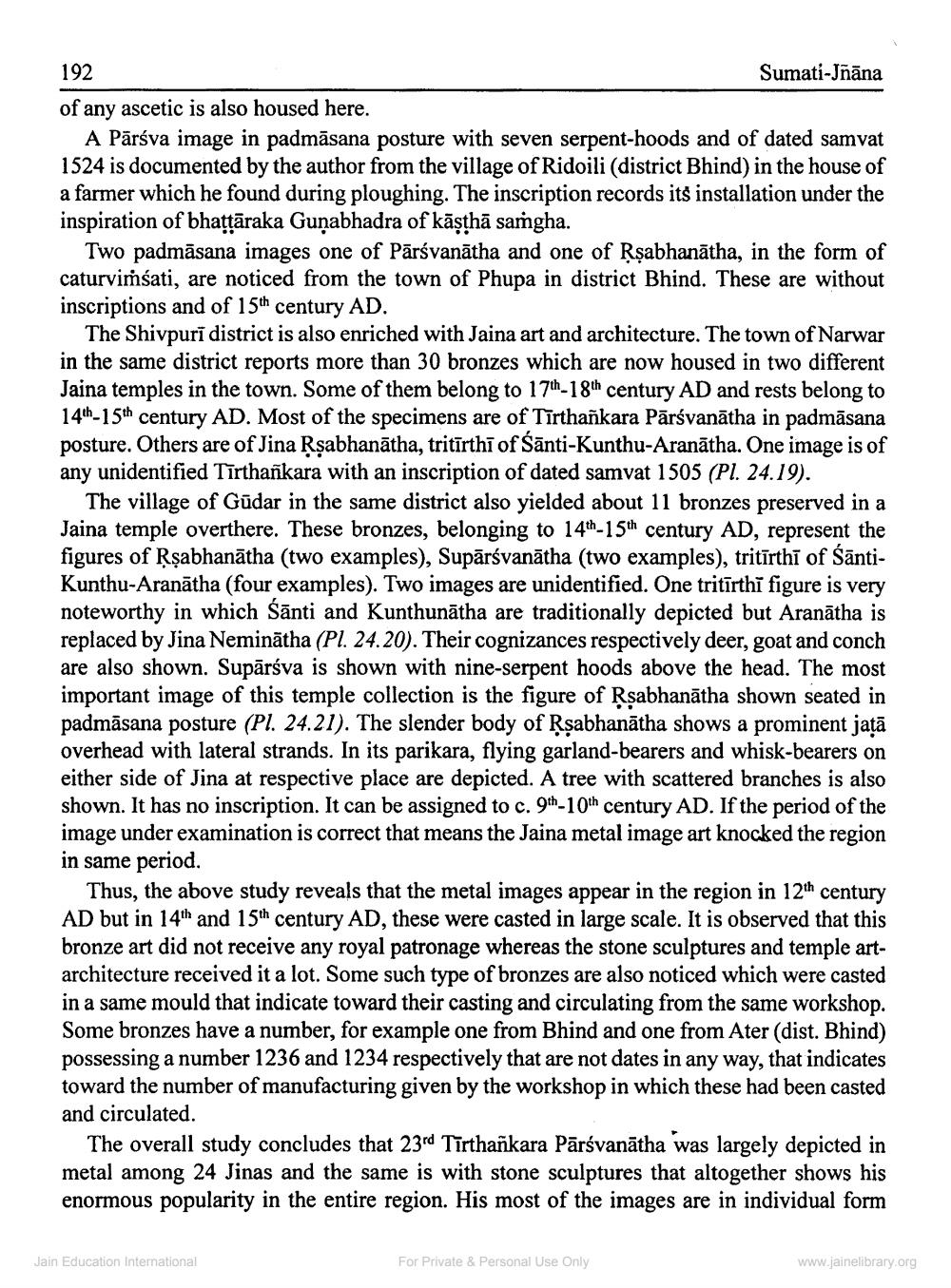________________
192
of any ascetic is also housed here.
A Pārśva image in padmāsana posture with seven serpent-hoods and of dated samvat 1524 is documented by the author from the village of Ridoili (district Bhind) in the house of a farmer which he found during ploughing. The inscription records its installation under the inspiration of bhaṭṭāraka Gunabhadra of kāṣṭhā saṁgha.
Sumati-Jñāna
Two padmāsana images one of Pārsvanatha and one of Ṛṣabhanatha, in the form of caturviṁśati, are noticed from the town of Phupa in district Bhind. These are without inscriptions and of 15th century AD.
The Shivpuri district is also enriched with Jaina art and architecture. The town of Narwar in the same district reports more than 30 bronzes which are now housed in two different Jaina temples in the town. Some of them belong to 17th-18th century AD and rests belong to 14th-15th century AD. Most of the specimens are of Tirthankara Pārsvanatha in padmāsana posture. Others are of Jina Ṛṣabhanatha, tritīrthī of Śānti-Kunthu-Aranatha. One image is of any unidentified Tirthankara with an inscription of dated samvat 1505 (Pl. 24.19).
The village of Gūdar in the same district also yielded about 11 bronzes preserved in a Jaina temple overthere. These bronzes, belonging to 14th-15th century AD, represent the figures of Rṣabhanatha (two examples), Supārśvanatha (two examples), tritīrthī of ŚāntiKunthu-Aranatha (four examples). Two images are unidentified. One tritirthi figure is very noteworthy in which Santi and Kunthunatha are traditionally depicted but Aranatha is replaced by Jina Neminatha (Pl. 24.20). Their cognizances respectively deer, goat and conch are also shown. Supārśva is shown with nine-serpent hoods above the head. The most important image of this temple collection is the figure of Rṣabhanatha shown seated in padmāsana posture (Pl. 24.21). The slender body of Rṣabhanatha shows a prominent jaṭā overhead with lateral strands. In its parikara, flying garland-bearers and whisk-bearers on either side of Jina at respective place are depicted. A tree with scattered branches is also shown. It has no inscription. It can be assigned to c. 9th-10th century AD. If the period of the image under examination is correct that means the Jaina metal image art knocked the region in same period.
Thus, the above study reveals that the metal images appear in the region in 12th century AD but in 14th and 15th century AD, these were casted in large scale. It is observed that this bronze art did not receive any royal patronage whereas the stone sculptures and temple artarchitecture received it a lot. Some such type of bronzes are also noticed which were casted in a same mould that indicate toward their casting and circulating from the same workshop. Some bronzes have a number, for example one from Bhind and one from Ater (dist. Bhind) possessing a number 1236 and 1234 respectively that are not dates in any way, that indicates toward the number of manufacturing given by the workshop in which these had been casted and circulated.
The overall study concludes that 23rd Tirthankara Pārsvanatha was largely depicted in metal among 24 Jinas and the same is with stone sculptures that altogether shows his enormous popularity in the entire region. His most of the images are in individual form
Jain Education International
For Private & Personal Use Only
www.jainelibrary.org




